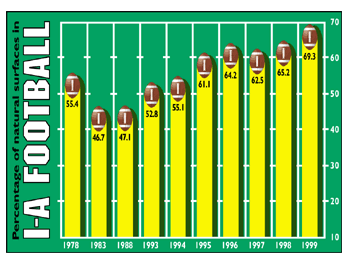
National Collegiate Athletic Association |
The NCAA News DigestAugust 30, 1999
Natural look continues to grow in I-A football
According to the latest edition of NCAA Football, the official record book of college football, Division I-A will contain 114 members in 1999, 79 of which (69.3 percent) will play on natural surfaces. That is a significant change from last year when 73 of 112 members (65.2 percent) played on natural surfaces. The two new Division I-A members are the State University of New York at Buffalo (grass surface) and Middle Tennessee State University (AstroTurf). Existing Division I-A institutions that reported a switch from an artificial surface to a natural one for 1999 included the University of Colorado, Boulder; Oregon State University; the University of Nevada, Las Vegas; and Vanderbilt University. Also, the University of Houston now plays exclusively on campus at Robertson Stadium (grass) rather than the Astrodome. The percentage of Division I-A members playing on grass surfaces has increased steadily since the early '80s, when more than half the teams played on artificial surfaces. By 1994, however, more than 60 percent of the Division I-A membership was playing on a natural surface. Current Division I-A teams using natural surfaces
Air Force
Current Division I-A teams using artificial surfaces
FINANCESExecutive Committee approves $303.3 million budget The NCAA Executive Committee has approved an operating budget of $303.3 million for fiscal year 1999-00, an increase in revenue of 7.2 percent achieved largely from scheduled increases in television rights fees. The committee approved the budget during its August 6 meeting in Indianapolis. Staff contact: James L. Isch.
GRADUATION RATESLittle change noted in most recent papers The most recent Division I graduation-rate report shows that Division I student-athletes graduate at a higher rate than the general student body. Of the student-athletes in the 1992 entering class, 58 percent graduated within six years. The collective student body during the same period posted a 56 percent graduation rate. Meanwhile, the second set of graduation rates for Division II student-athletes showed little overall change from the first study, which was compiled last year. The 1999 NCAA Divisions II and III Graduation-Rates Report showed that 49 percent of Division II student-athletes in the 1992 entering class graduated within six years. That is slightly higher than the 48 percent rate noted with the 1991 entering class. The graduation rate for the overall Division II student body jumped from 41 to 43 percent. Both reports were mailed in late August. Staff contacts: Todd A. Petr.
BASKETBALLThousands participate in Final Four ticket drawings Almost 174,000 entries for tickets for the 2000 Men's Final Four were received from the general public this year, the second largest figure in history. Meanwhile, a sellout was assured for the Women's Final Four for the eighth consecutive year. Members of the general public whose entries were selected for the 2000 Men's and Women's Final Fours were notified in letters that were mailed in mid-August. Refunds were provided at the same time to those whose names were not selected. The 2000 Men's Final Four will be played at the RCA Dome in Indianapolis, while the Women's Final Four will take place at the First Union Center in Philadelphia. Staff contacts: Bernard Muir.
COMPLIANCENCAA, NFHS schedule September 15 video conference The NCAA and the National Federation of State High School Associations will conduct a rules video conference from 7-9 p.m. Eastern time Wednesday, September 15. The program -- designed for students, parents and high-school administrators -- will focus on many issues, including initial eligibility and the NCAA Initial-Eligibility Clearinghouse process, the core-course review process, matters related to students with disabilities, and basic recruiting rules. Representatives from the NCAA and the NFHS will appear on the panel. Satellite coordinates are C Band Galaxy 6 transponder 7. The program can be accessed only by a steerable or movable satellite dish (rather than services such as DSS Primestar, USSB, Channel One or DirecTV). The troubleshooting number will be 317/481-0060. Staff contacts: Gordon C. Finch.
|
 Natural look continues to grow in I-A footballThe move toward grass in Division I-A football has accelerated, with almost 70 percent of the teams in the subdivision now playing on a natural surface.
Natural look continues to grow in I-A footballThe move toward grass in Division I-A football has accelerated, with almost 70 percent of the teams in the subdivision now playing on a natural surface.